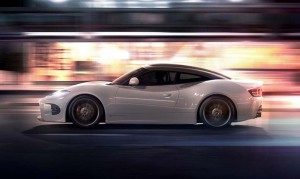One thing you can say about Victor Muller: he doesn’t give up easily. “I am persistent,” says the Dutch entrepreneur as he catches his breath between interviews and meetings at the Geneva Motor Show.
Many thought Muller might call it quits on the auto industry after his effort to save the Swedish carmaker Saab collapsed in the waning days of 2011. At the time, it looked like he would also be forced to sell the tiny sports car company he had launched a decade earlier.
But while Saab collapsed – an issue that Muller continues to deal with in a $3 billion lawsuit he has filed against the maker’s former owner, General Motors – he wound up keeping Spyker and now hopes to bring it back to life with the introduction of the new B6 Venator. A concept version is on display at Geneva’s PALExpo convention center and generating a fair amount of interest.
The B6 is a compact, mid-engine sports car that picks up on some of the aerospace-influenced design cues of earlier, often outlandish Spyker models, such as the Aileron. That includes not just its propeller logo but an aircraft-like canopy that sweeps rearward to reduce drag, LED taillights that are designed to look like the afterburners of a fighter jet, and turbofan-style wheels. The aero theme carries over into the interior, where there’s an airplane-style ignition switch, a turned aluminum dash and jet-like gauges.
The V-shaped radiator grille, meanwhile, harkens back more than a century to the original Spyker – A Dutch automaker which failed during the Great Depression. Back in its heyday, it was known for its successful race cars.
The production B6, meanwhile, will use a mix of aluminum and carbon fiber for its chassis and skin to keep weight down to around 3,000 pounds, the sports car’s V-6 expected to deliver 375 horsepower through a six-speed gearbox.
Muller hopes to have the B6 Venator in production by autumn 2014. But he also plans to follow it up with several other product lines, including a “super” sport-utility vehicle.
As with just about any luxury car manufacturer, Muller knows he has to target the U.S., and a prototype of the B6 is now being homologated, or tweaked to meet American regulatory mandates, but it’s China, he says, that “is going to be our number one market – and for every supercar manufacturer over time,” he quickly adds.
(China likely to be world’s number one luxury car market by 2020. Click Here for that report.)
The former lawyer’s interest in China is understandable. His key investor is Youngman Lotus, a Chinese company that currently holds a 29.9% stake in the firm. Youngman previously hoped to team up with Muller in his bid to salvage Saab. But that company and several other Chinese firms were unable to complete their bids because GM refused to allow the Swedish maker to share with them intellectual property developed by the U.S. maker.
A hearing on Muller’s lawsuit will take place in April and, if it succeeds, could make the already wealthy Muller significantly richer. But for now, he insists, he won’t make the same, ultimately fatal mistake he did with Saab, promising that with Youngman’s help, Spyker’s comeback plans are well-funded.
“They have very deep pockets,” he hints, without discussing specifics of Spyker’s cash resources.
The program calls for the maker to stage its comeback with the relatively high-volume B6, which would be the lowest-cost Spyker, though still nudging six figures. The goal is sales “in the 100s, not the 10s,” explains John Walton, a former senior executive at Aston Martin who is not Muller’s second-in-command.
The next move would be a slightly larger, or C-segment sports car, with a sports car/sport-ute amalgam to follow based on the SSUV concept Spyker revealed six years ago.
“The market has changed,” says Walton, “and you’ve got to have more than one vehicle.”
The Geneva Motor Show helps put Spyker’s plans into perspective. The annual event is a bit unusual among world-class car shows in that major manufacturers and scores of small, automotive wannabes exhibit side-by-side. And Spyker is just one of many. But the Youngman connection certainly offers the cash resources few others can boast.
Walton, meanwhile, is working out a sales and marketing strategy that can help Spyker increase its appeal and reach. Rather than simply signing up dealers and hoping they’ll put some effort into marketing your product, Spyker plans to create a more “bespoke experience,” says Walton that will make it easier to not only find potential customers but also give them a sales experience tailored to their needs, desires – and available time. In the U.S., vehicles will still be delivered through regular dealers to comply with state franchise laws.
There are, in fact, lots of laws to comply with, especially if you’re marketing your cars worldwide. And some of the toughest could be the increasingly stringent emissions and fuel economy standards going into effect from Berlin to Boston to Beijing.
Muller says Spyker will respond as necessary. The B6’s relatively small engine should sidestep restrictions in markets like China that tax according to displacement. And, going forward, the company has other options.
“What better way that to bring in small electric cars?” asks Muller, as he is reminded he’s late for another interview. It’s only an idea for now, he concludes, suggesting it will be a topic for a future conversation.


